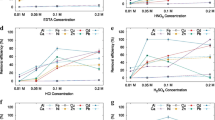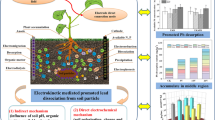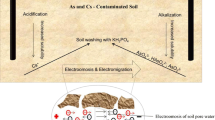Abstract
The transport of P sources (organic and inorganic phosphorus) using electrokinetic process through a low-permeability soils was investigated. A series of batch experiments was conducted to construct the adsorption isotherms of KH2PO4 and triethyl phosphate (TEP) on kaolin soils. Approximately 60.3% of phosphorus from KH2PO4 was adsorbed within 24 hours, and the maximum adsorption (73%) was attained at 6 days after adsorption. In contrast, TEP showed no P adsorption in 7 days, thus suggesting an alternative P source that may maintain a favorable proportion of C∶N∶P through the effective delivery duringin situ bioremediation in low permeability soils. Experiments using electrokinetic process were carried out with electrokinetic reactor having a hydraulic conductivity of 1.99×10−7 cm s−1 for a 0.01 M NaCl aqueous solution. TEP and KH2PO4 were used as organic P source and inorganic P source, respectively, and introduced individually into a chamber near the platinum anode and near the platinum cathode, respectively. Potassium dihydrogen phosphate was not distributed uniformly along the soil column and most of transported phosphorus was changed to water-insoluble aluminum phosphate after 12 days of treatment, indicating the decrease of bioavailability of the phosphorus. In case of TEP, the advancing P front progressed with time, resulting in uniform P distribution through the kaolin column. In terms of transport, organic phosphorus, TEP, would be a more effective P source than inorganic phosphorus, KH2PO4, in electrokinetic enhanced bioremediation.
Similar content being viewed by others
References
Brady, N.C. and Well, R.R., 2002. The nature and Properties of Soll. Pearson education (13ed), New Jersey, 277 p.
Brown, R.A., McCarty, P.L., Semprini, L., Wilson, J.T., Kampbell, D.H., Reinhard, M., Bower, E.J., Borden, R.C., Vogel, T.M., Thomas, J.M. and Ward, C.H., 1996, Handbook of Bioremediation. Lewis Publishers, Florida, 227 p.
Budhu, M., Rutherford, M., Sills, G. and Rasmussen, W., 1997, Transport of nitrates through clay using electrokinetics. Journal of Environmental Engineering, 123, 1251–1253.
Chang, S.C. and Jackson, M.L., 1956, Fractionation of soil phosphorus. Soil Science, 84, 133–144.
Chilingar, G.V., El-Nassir, A. and Stevens, R.G., 1970. Effect of direct electrical current on permeability of sandstone cores. Journal of Petroleum Technology, 22, 830–836.
Environmental Protection Agency, 1985, Handbook of Remedial Action at Waste Disposal Sites (revised). EPA/625/6-85/006, Environmental Protection Agency, USA, 15 p.
Haynes, R.J., 1984, Lime and phosphate in soil-plant system. Advances in Agronomy, 37, 249–315.
Mitchell, J.K., 1993, Fundamentals of Soil Behavior. Wiley and Sons, New York, 228 p.
Morel, J.L., Fardeau, J.C., Beruff, M.A. and Guckert, A., 1989, Phosphate fixing capacity of soils: a survey, using the isotopic exchange technique for soils from north-eastern France. Fertilizer Resources, 19, 103–111.
Rabbi, M.F., Clark, B., Gale, R.J., Ozsu-Acar, E., Pardue, J.H. and Jackson, W.A., 2000, In situ TCE bioremediation study using electrokinetic cometabolite injection. Waste Management, 20, 279–286.
Ro, H.M. and Cho, C.M., 2000, Diffusive phosphate transport in Alrich acidic porous cation exchange system. Canadian Journal of Soil Science, 80, 551–560.
Rubeiz, I.G., Streohlein, J.L. and Oebker, N.F., 1992, Availability and fixation of phosphorous from urea phosphate incubated in a calcareous soil column. Communications in Soil Science and Plant Analysis, 23, 331–335.
Sakadevan, K. and Bavor, H.J., 1998, Phosphate adsorption characteristics of soils, slagtros and zeolite to be used as substrates in constructed wetland systems. Water Research, 393–399.
Sposito, G., 1989, The Chemistry of Soils. Oxford University Press, Oxford, 150–154.
Suflita, J.M. and Sewell, G.W., 1991, Anaerobic Biotransformation of Contaminants in the Subsurface. EPA/600/M-90/024, Enviromental Protection Agency, USA, 11 p.
Thevanayagam, Y.S. and Rishindran, T., 1998, Injection of nutrients and TEAs in clayey soils using electrokinetics. Journal of Geotechnical and Geoenvironmental Engineering, 124, 330–338.
Thomas, J.M. and Ward, C.H., 1994, Introduced organisms for subsurface bioremediation. Handbook of Bioremediation, Lewis Publishers, Florida, 227–244.
West, C.C. and Harwell, J.H., 1992, Surfactants and Subsurface Remediation, Oxford University Press, Oxford, 2324 p
Yeung, A.T. and Mitchell, J.K., 1993, Coupled fluid, electrical and chemical flows in soil. Geotechnique, 43, 121–134.
Zelina, J.P. and Rusling, J.F., 1998, Electrochemical remediation of soils. In: Meyers, R.A., Encyclopedia of Environmental Analysis and Remediation, Wiley and Sons, New York, 3, 1567–1583.
Author information
Authors and Affiliations
Corresponding author
Rights and permissions
About this article
Cite this article
Lee, G., Ro, H., Lee, S. et al. Electrokinetically enhanced transport of organic and inorganic phosphorus in a low permeability soil. Geosci J 10, 85–89 (2006). https://doi.org/10.1007/BF02910335
Received:
Accepted:
Issue Date:
DOI: https://doi.org/10.1007/BF02910335




